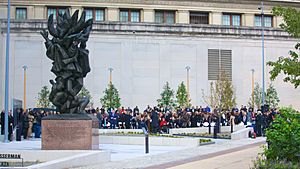Horwitz-Wasserman Holocaust Memorial Plaza facts for kids
The Horwitz-Wasserman Holocaust Memorial Plaza is a special park in Philadelphia, Pennsylvania. It helps people remember the Holocaust, a terrible time in history when millions of Jewish people were killed. The park is located where Benjamin Franklin Parkway, 16th Street, and Arch Street meet. It has a monument called the Monument to the Six Million Jewish Martyrs, which was first opened in 1964. The plaza was made much bigger in 2018, adding new features to help visitors learn and remember.
History of the Memorial Plaza
On April 26, 1964, a group of Holocaust survivors in Philadelphia, called the Association of Jewish New Americans, worked with another group to open the Monument to the Six Million Martyrs. This monument was one of the very first public memorials in the United States dedicated to the Holocaust.
The monument was designed by an artist named Nathan Rapoport. It shows a flame that looks like a burning bush from the Bible. Inside the flame, you can see figures of people suffering. Some hands hold a Torah scroll, which is a holy Jewish text. Other hands are shown as fists holding daggers, symbolizing resistance and fighting back. The monument reminds us of the biblical story where a bush burned but was not destroyed, and God promised to save the Jewish people.
The Philadelphia Holocaust Remembrance Foundation worked hard to protect this important monument. They also planned to make the area around it better with more historical items and educational displays. The expanded plaza was finished and opened in October 2018.
What You Can See at the Plaza
Besides the Monument to the Six Million Jewish Martyrs, the plaza has several other important features that help tell the story of the Holocaust:
- Six Pillars: There are six tall pillars, one for each million Jewish people who died in the Holocaust. These pillars show how the terrible events of the Holocaust were different from the protections and values found in the American Constitution.
- Train Tracks: You can see three real train tracks that were once used to transport people to death camps. These camps were places where people were imprisoned and killed during the Holocaust.
- Theresienstadt Sapling: A young silver maple tree grows here. This tree is a sapling (a young tree) from an original tree that was cared for by children in the Theresienstadt Ghetto. A ghetto was a part of a city where Jewish people were forced to live.
- Tree Grove: A group of trees represents the forests where partisans hid. Partisans were brave fighters who resisted the Nazis during the war.
- Remembrance Wall: This wall has a special eternal flame that never goes out. The flame is a symbol of hope and remembrance.
The plaza also uses a mobile app called IWalk, created by the USC Shoah Foundation. This app provides multimedia content, like videos and stories, to help visitors learn more as they walk through the plaza.
Why This Plaza Is Important
The Philadelphia Holocaust Remembrance Foundation says that the plaza helps people understand the dangers of totalitarianism. Totalitarianism is a type of government where one person or group has complete control over everything, and people have no freedom. The plaza teaches how staying true to the Constitution of the United States can prevent such dangers in America. It reminds everyone about the importance of freedom and human rights.


